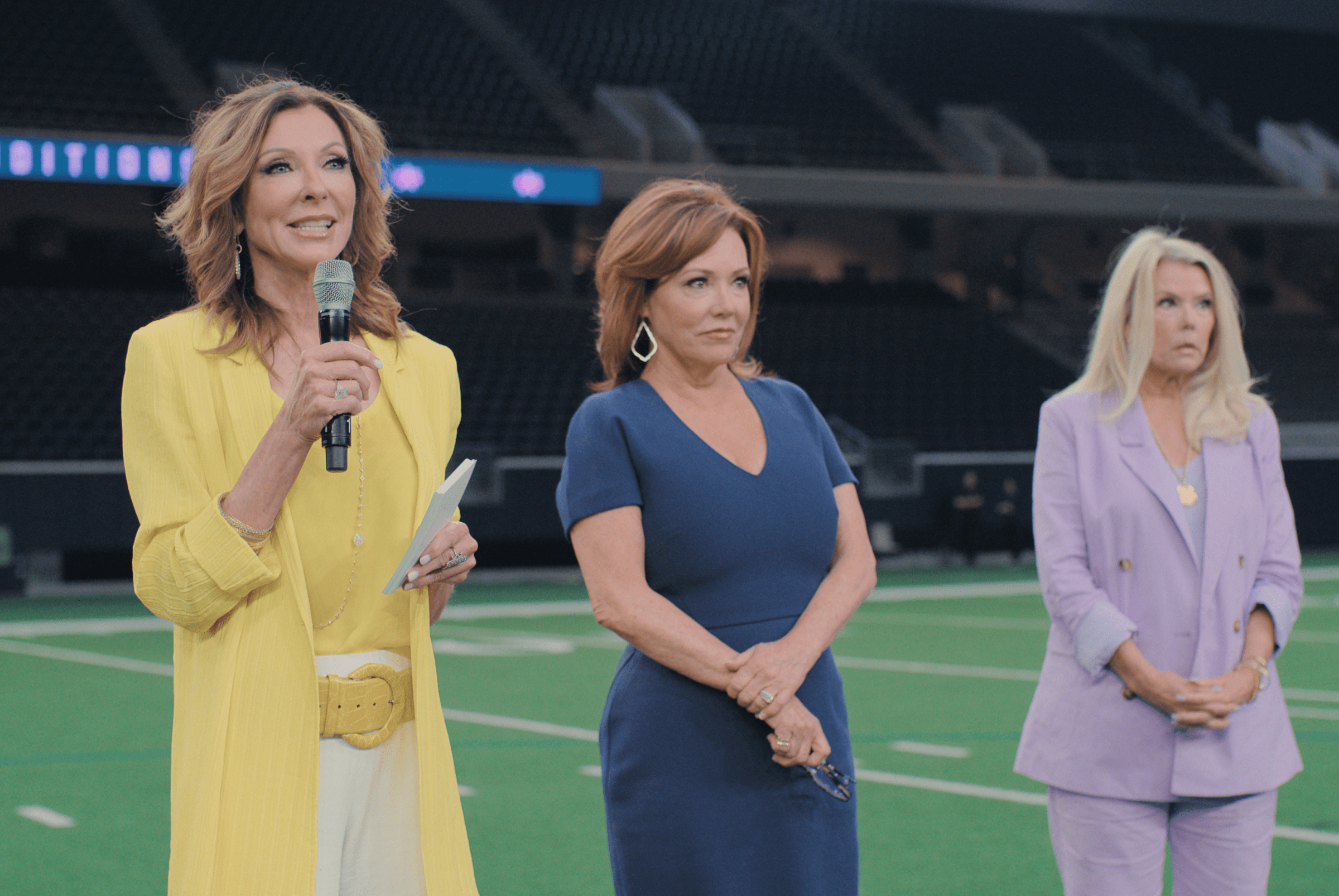One of the credos for the Dallas Cowboys Cheerleaders is that cheerleaders, by their definition, are supposed to make everyone feel better — even when they themselves aren’t feeling particularly cheerful. That seems innocent enough, but across the seven hours of Netflix’s America’s Sweethearts: Dallas Cowboys Cheerleaders, we see DCC management weaponize this altruism to inflict a host of harms, from eating disorders and broken hips to embarrassingly low wages and performances in horrendous temperatures. Now, after watching the series, I think I betterunderstand one of the most dark-sided frauds ever perpetrated on American women.
The punishing system that creates these picture-perfect performers is built on a pyramid of harmful ideals, sky-high expectations, regressive beauty standards, dangerous physical demands, seductive but false ideas of sisterhood, and exploitative working conditions. Throughout the show, we witness firsthand behavior that’s usually only brought to light when someone decides to blow a whistle on a sorority, a fraternity, or a cult: the type of manipulation and skewed thinking that’s usually never discussed until the traumatic ordeal is over.
The most compelling thing about America’s Sweethearts isn’t that this behavior exists. It’s that it’s all caught proudly on camera.
The seven-episode docuseries centers on the creation of the 2023 DCC squad. Each year, veteran cheerleaders and rookies try out in the hope of snagging one of the 36 spots. The rule is that you can be a DCC for five years but have to try out each time, competing with a fresh set of younger, more athletic, perhaps more talented newbies.
From the jump, we’re told how important the DCC have been to the Cowboys; the squad is perhaps just as famous as the professional football players when it comes to brand recognition. From calendars to magazine spreads to Barbies, the Dallas Cowboys Cheerleaders are a money-making entity for the billion-dollar organization. They’re a business within a business, one that doesn’t depend on winning seasons as much as it does visibility.
Determining who makes it and who gets cut are director Kelli Finglass and her henchwoman and head choreographer Judy Trammell. Kelli and Judy, as they explain to the camera, are both DCC alumni appointed by Charlotte Jones, a scion to the ultra-rich family that owns the Cowboys. Since the ’90s, Kelli and Judy (but primarily Kelli) have been tasked with turning the DCC into an extremely popular, super profitable, impossibly wholesome and simultaneously sexy cheerleading squad. This means Kelli and Judy must ensure the cheerleaders stay relevant and desirable year in and year out.
America’s Sweethearts isn’t the DCC’s first reality rodeo. Kelli and Judy were part of another DCC series, Dallas Cowboys Cheerleaders: Making the Team, which began in 2006 and ran for 16 seasons on CMT before moving to Netflix.
“Welcome to the Dallas Cowboys Cheerleaders, we hope you survive the experience!”Netflix
As Kelli and Judy admit, both were inducted into the DCC in an era when there was less emphasis on dancing skills. It’s unclear whether their current authority is based on real-life experience or just handed down from the Jones family. Yet, they inflict their arbitrary standards of “professionalism” and “appeal” with a self-righteous confidence.
Like the guards who ran with too much power in the Stanford Prison Experiment, Kelli and Judy whittle down DCC training camp to those 36 spots in sometimes cruel ways. Their cuts and critiques look more like hazing than business decisions. They’re shown ripping one hopeful’s appearance after giving her the brunette makeover that they find so unappealing, picking apart the smiles of women who applied online, and asking each other “What’s her …? She’s Indian?” when evaluating a South Asian dancer during live auditions.
One of the most pathos-filled examples of this is the strange ire the two seem to harbor toward four-year veteran Victoria Kalina. I say “seem to” because Kelli and Judy never say they don’t respect Victoria, but they certainly act like it. Victoria is, according to DCC lore, the daughter of alumnae Tina Kalina, who Kelli and Judy describe as one of the most alluring cheerleaders ever to put on the Dallas Cowboys Cheerleaders uniform. Ostensibly the pair — especially Kelli — are friends with Tina and cannot be as mean to her daughter as they are to the women whose moms aren’t former DCCs. Somehow this results in something even meaner.
Victoria’s legacy affords her some protection, but also yokes her to a bad situation that clearly makes her feel terrible about herself. Kelli and Judy tell Victoria in so many ways that not only does her personality pale in comparison to her mother, but that she also needs to lose weight.
“I think it’s harder for girls not to just wanna starve themselves,” Victoria says in a confessional, as the camera shows Victoria eating a lunch that consists of a bowl of watermelon, three or so slices of turkey sandwich meat, and two rice cakes. Victoria and other DCC vets and alums explain that the uniform they wear, particularly the hot pants, are tailored to their bodies and aren’t resized. That means veterans, especially four- and five-time returning stalwarts, have to keep their bodies the same size over the course of years.
When Victoria looks at the uniform, she says, she thinks, “Oh man, I need to lose at least three pounds.” It is heavily indicated that she took time off to get healthy after a bout with disordered eating.
Victoria, one of the show’s star cheerleaders, isn’t the coach’s favorite. And they tend to remind her at every opportunity.Netflix
Throughout the season, when Victoria and her cohort aren’t performing to Kelli and Judy’s standard, they ask Victoria and the other women if they are “fueling” themselves properly — a nutrition double-speak to ask if they’re eating. That might pass as genuine concern if the DCC set these women up with resources like nutritionists or trainers. Or if Kelli and Judy hadn’t been captured throughout the series, and in archival footage, haranguing women about their midsections.
Much of this fueling, practicing, criticism, and self-recrimination happens in the name of a routine called “Thunderstruck.” Throughout the series, candidates and coaches talk about “Thunderstruck” as if it were some holy ritual, and as though you’re an alien from a different planet if you’ve never heard of the classic routine set to a whirling, waa-waaa-ing 1990 AC/DC song. Judy explains over and over again that “Thunderstruck” is so complicated that even though the DCC attracts the best dancers, many of them ballet- and jazz-trained, few of them are able to perform “Thunderstruck” to her liking.
To be clear, I am no dancer and not up to date on the nuances of dance, but the moves in “Thunderstruck” are predominantly fancy prances, body rolls, and hair tosses, choreographed in the loosier-goosier era of the DCC’s dance standards. If one can rhythmically undulate from their hips and has enough hair to fling, one can perform the majority of “Thunderstruck.”
Judy and Kelli both admit that even today, their selections are more about the overall appeal of a DCC cheerleader than her dancing ability. Despite their strict expectations, they constantly, accidentally raise questions about their own credentials. If routines like “Thunderstruck” are passed down from DCC class to DCC class, then what “choreography” is Judy bringing to the table? If dancing wasn’t required of her to be a cheerleader, what makes her fit to lead now? And further, what kind of excellence does Kelli possess? Other than her supernatural ability to make the beautiful and talented women trying out feel so ordinary and wanting.
With Kelly and Judy picking apart their appearances and stuffing them into shorts that they may have to fit into for five years, the DCC — rookies and vets — are seen helping each other and forming strong friendships. They do things together like teach Reece, a rookie and recent Alabama graduate, what to order at Starbucks since she has never ordered from a Starbucks before (she gets a strawberry refresher because she likes strawberries).They have prayer circles where they talk about grace and forgiveness and share stories about dancing as kids. They all show up for each others’ engagement parties. Even Victoria is seen taking rookies under her wing and teaching them steps. This is the camaraderie and wholesomeness that the organization — all the way up to Charlotte Jones, the filthy-rich nepo baby Judy and Kelli answer to— loves to talk about on camera. These beautiful, talented, friendly women are the face of the Dallas Cowboys Cheerleaders. They’re so valuable.
But this spirit is so thoroughly undercut by the behavior of the women in charge that you wonder if this sisterhood is something that exists in spite of management rather than because of it.
In the final two episodes, Sophy, a returning veteran, is part of an off-camera incident. During the Thanksgiving Game, she tells DCC officials and police that a cameraman at the game inappropriately touched her as she was coming onto the field during the third quarter. The news eventually reaches Kelli, who is busy reading DCC praise off her phone (Dolly Parton was a surprise halftime performer with the squad).
Kelli almost dismisses it at first, stating that Sophy “is talking to the right people” and not getting up from her seat. Then, she makes eye contact with the camera, seems to remember she’s being filmed, and then asks about how Sophy is. Kelli eventually pulls Sophy off the field and asks if she needs water. No one from the DCC sits with Sophy as she gives her statement to the police, and in a title card, the show explains that the police were not able to pursue the charges.
The most damning material, though, might come from extensive interviews with Kat Puryear and Caroline Sundvold, two DCC alums who spell out what happens when your years (a max of five) with the DCC are done.
While the pair remain heavily involved in the DCC social world — attending engagement parties and alumni events — they honestly explain that post-cheerleader life is like falling back to Earth. Caroline, who is hobbling on a walker or crutches at a couple of points in the series, explains that five years of jump-splitting (a jump where you land in the splits) in “Thunderstruck” tore her hips to the point of requiring surgery. She also needed foot surgery after her season and was, at the beginning of the series, sharing a studio apartment with her sister Anna Kate, who she encouraged to try out for DCC. Caroline, who seems to be wandering in a depressive fog, wonders out loud if her glory days are done.
According to Dallas Cowboys Cheerleaders, once you make the team your uniform can never be re-sized. For some women, that means wearing the same size of hot pant for five years.Netflix
Kat, an alum of the same year, tells the camera that it’s been hard to find a job after DCC. In between applying for interviews, Kat explains that the pay for a DCC is comparable to a fast food worker. Should one become a DCC, pay is allegedly $15-$20 per hour, $500 per game day, and up to $75,000 per year, provided the cheerleaders take advantage of professional and event appearances. The lack of pay explains why most of the women trying out for the DCC have day jobs; some of them are nurses or orthodontists. Meanwhile, the Dallas Cowboys organization is, according to Sports Illustrated, worth $9.2 billion and had a 2022 revenue of $1.05 billion.
One would think that the DCC, which is so important to the Dallas Cowboys — as Kelli, Judy, and their boss Charlotte constantly remind us — would be worth more than what they’re being paid. The Dallas Cowboys certainly have enough money to do it.
Making someone believe that belonging to something is so crucial to their existence that they should give up things that make them happy is exactly the kind of quality that the most effective cult leaders possess. As is constantly reminding your followers that they’re part of a “sisterhood” or “family” or “something special,” as Kelli, Judy, and their boss Charlotte also like to say, all of which apparently outweigh things like your health or financial security.
The DCC are far from the only women in the US told they should be honored at the opportunity to fit into a narrow and deleterious mold, from pageant queens to sorority rushes to even new mothers and women on dating apps, these kinds of sharp, exhausting standards are de rigueur in American life. Like a pair of DCC hot pants, it’s all a trap — but it’s easier to see when women are starving themselves to fit into unyielding short shorts.
The natural question is whether the hunger, humiliation, low pay, broken hips, and casual judgment of Kelli and Judy are all worth it. Perhaps there’s some kind of calculus to becoming a Dallas Cowboys Cheerleader that we’re still not privy to. Maybe there’s something there that seven hours couldn’t possibly capture. Or perhaps that rationalization is part of the same hollow fantasy that fuels the DCC.














![ROSE IN DA HOUSE I BE MY BOYFRIENDS 2 [OFFICIAL TRAILER]](https://cherumbu.com/wp-content/uploads/2022/01/ROSE-IN-DA-HOUSE-I-BE-MY-BOYFRIENDS-2-OFFICIAL-150x150.jpg)

